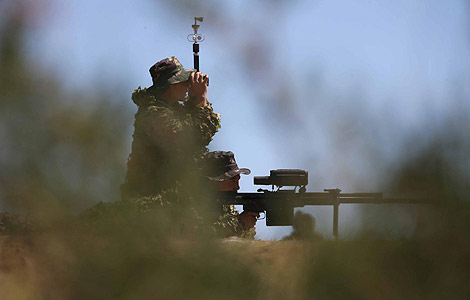Arrival of China tigers put on hold
Updated: 2013-07-27 08:48
By Yang Yao (China Daily)
|
|||||||||||
He said China is building a primary base at the Meihuashan Chinese Tiger Breeding and Rehabilitation Center in Fujian province and is preparing to welcome the tigers.
"The base is scheduled to be finished by the end of this year," he said. "But this has not been finalized."
According to Lu, once the tigers born and raised in South Africa become used to their new environment and prey, they will be sent to natural protection zones at Houhe in Hubei province, Matoushan in Jiangxi province and Hupingshan in Hunan province.
But Quan Li said the tigers cannot arrive before work on fence-building and prey recovery is completed in the zones.
Yan Xun, the State Forestry Administration's chief engineer for wildlife conservation, said the nation is accelerating the plan for the tigers' arrival, but as the projects need approval from different levels of government, the exact date is up in the air.
Scientists now suggest that Xishuangbanna in Yunnan province may be an ideal habitat for the tigers.
"The natural rain forests there are abundant, have a rich prey base and, most importantly, Indochinese tigers have already been there," said Feng Liming, a wildlife professor at Peking University.
She said the latest research shows that the genes of Indochinese and South China tigers are basically the same, so locating South China tigers there should not be a problem.
However, Lu Jun said there is not sufficient scientific proof to show that the two subspecies are the same.
Hua Ning, China program director at the International Fund for Animal Welfare, questioned the training to return tigers to the wild, saying there has been no successful examples of this worldwide.
Training going well
But scientists confirmed the role that such training played in saving the South China tigers, in an assessment report made in October 2010 at Laohu Valley Reserve in South Africa.
David Smith, a professor of wildlife studies at the University of Minnesota, an expert who worked on this project, said the training has been going well in South Africa and the tigers from China are quite capable at hunting.
"This would be the first successful tiger rewilding," Smith said. "We all look forward to seeing China take a lead in reintroducing the tigers. This would set an example to many other countries."
Before this program started, no South China tigers had been seen in the wild, and only around 70 in captivity, all in Chinese zoos.
This tiger subspecies, which was native to Fujian, Guangdong, Hunan and Jiangxi provinces, has been classified as critically endangered by the International Union for Conservation of Nature and Natural Resources since 1996 due to a low density of prey, widespread habitat degradation and fragmentation and other human pressures.
Related Stories
Tiger still in the Woods as early challenge fizzles out 2013-07-23 07:21
Newborn tiger cubs make debut in C China 2013-07-04 09:29
Wild Siberian tiger eats oxes in NE China 2013-06-26 17:13
Dogs feeding baby tigers in Shanghai zoo 2013-06-20 20:19
Marauding Siberian tigers kill livestock 2013-05-10 07:54
Today's Top News
Solar duties to harm EU: Danish trade minister
Chinese developer buys LA site for $1b project
Snowden faces another 6 months in limbo: official
Arrival of China tigers put on hold
Deadly NE China fire an act of arson: police
Hot times for travel agents
China, Russia boost ties with joint drills
Sovereign fund sees 10.6% return
Hot Topics
Lunar probe , China growth forecasts, Emission rules get tougher, China seen through 'colored lens', International board,
Editor's Picks

|

|

|

|

|

|





